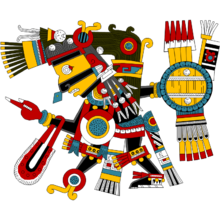
Back تيزكاتليبوكا Arabic Tezcatlipoca Breton Tezcatlipōca Catalan Tezcatlipoca German Τεζκατλιπόκα Greek Tezcatlipoca Spanish Tezcatlipoca Basque تزکاتلیپوکا Persian Tezcatlipoca Finnish Tezcatlipoca French
| Tezcatlipoca | |
|---|---|
| Member of the Tezcatlipocas | |
 Tezcatlipoca as depicted in the Codex Borgia | |
| Other names | Black Tezcatlipoca, Ometeteosij |
| Abode |
|
| Symbol | Black Jaguar[1] |
| Gender | Male |
| Region | Mesoamerica |
| Ethnic group | Aztec, Tlaxcaltec, Toltec (Nahua) |
| Festivals | Toxcatl |
| Personal information | |
| Parents | Ometecuhtli and Omecihuatl (Codex Zumarraga)[1] |
| Siblings | Quetzalcoatl, Xipe-Totec, Huitzilopochtli (Codex Zumarraga)[1] |
| Consorts | Xochiquetzal, Huixtocihuatl, Xilonen, Atlatonan |
| Children | None |


Tezcatlipoca (/ˌtɛskætliˈpoʊkə/; Classical Nahuatl: Tēzcatlipōca [/teːskat͡ɬiːˈpoːkaʔ/]) or Tezcatl Ipoca was a central deity in Aztec religion. He is associated with a variety of concepts, including the night sky, hurricanes, obsidian, and conflict. He was considered one of the four sons of Ometecuhtli and Omecihuatl, the primordial dual deity. His main festival was Toxcatl, which, like most religious festivals of Aztec culture, involved human sacrifice.
Tezcatlipoca's nagual, his animal counterpart, was the jaguar. In the form of a jaguar he became the deity Tepeyollotl ("Mountainheart"). In one of the two main Aztec calendars (the Tonalpohualli), Tezcatlipoca ruled the trecena 1 Ocelotl ("1 Jaguar"); he was also patron of the days with the name Acatl ("reed"). A strong connection with the calendar as a whole is suggested by his depiction in texts such as the Codex Borgia and Codex Fejéváry-Mayer, where Tezcatlipoca is surrounded by day signs, implying a sort of mastery over them.[2]
A talisman related to Tezcatlipoca was a disc worn as a chest pectoral, called the anahuatl.[3] This talisman was carved out of abalone shell and depicted on the chest of both Huitzilopochtli and Tezcatlipoca in codex illustrations.[4][5]
The origins of Tezcatlipoca can be traced to earlier Mesoamerican deities worshipped by the Olmec and Maya. Similarities exist between Tezcatlipoca and the patron deity of the K'iche' Maya, Tohil, as described in the Popol Vuh. The name Tohil refers to obsidian and he was associated with sacrifice. The Classic Maya god of rulership and thunder, K'awiil (known to modern Mayanists as "God K", or the "Manikin Scepter"), was depicted with a smoking obsidian knife in his forehead and one leg replaced with a snake.[a][6] Although there are striking similarities between possible earlier imagery of Tezcatlipoca, archaeologists and art historians are split in the debate. It is possible that he is the same god that the Olmec and Maya term their "jaguar deity", or alternately that he is an Aztec expansion on foundations set by the Olmec and Maya, as the Aztecs routinely took deliberate inspiration from earlier Mesoamerican cultures.
- ^ a b c d e f g Robelo, Cecilio A. (1905). Diccionario de Mitología Nahoa (in Spanish). Editorial Porrúa. pp. 542–8. ISBN 970-07-3149-9. OCLC 987967866.
- ^ Miller & Taube 1993, p. 164.
- ^ Baquedano, Elizabeth, ed. (2014). Tezcatlipoca: Trickster and Supreme Deity. University Press of Colorado. doi:10.5876/9781607322887. ISBN 9781607322887.
- ^ "Personified knives". Mexicolore. Retrieved 11 April 2018.
- ^ "INAH Archaeologists discover Tlaloc shaped vessel and knives in offering the Templo Mayor". 5oy Mexico. 2013. Archived from the original on 2014-09-12.
- ^ Cite error: The named reference
:1was invoked but never defined (see the help page).
Cite error: There are <ref group=lower-alpha> tags or {{efn}} templates on this page, but the references will not show without a {{reflist|group=lower-alpha}} template or {{notelist}} template (see the help page).
© MMXXIII Rich X Search. We shall prevail. All rights reserved. Rich X Search